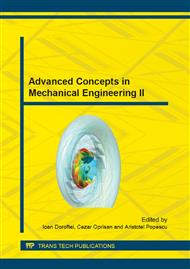[1]
K. Hyunwoo, C. Macosko, Morphology and Properties of Polyester/Exfoliated Graphite Nanocomposites, Macromolecules 41 (2008) 3317-3327.
DOI: 10.1021/ma702385h
Google Scholar
[2]
S. Swain, Synthesis and Characterization of Graphene Based Unsaturated Polyester Resin Composites, Transactions on Electrical and Electronic Materials 14 (2013) 53-58.
DOI: 10.4313/teem.2013.14.2.53
Google Scholar
[3]
V. Singh et all, Graphene based materials: Past, present and future, Progress in Materials Science 56 (2011) 1178–1271.
DOI: 10.1016/j.pmatsci.2011.03.003
Google Scholar
[4]
M. Aurilia, L. Sorrentino, S. Iannace, Modelling physical properties of highly crystallized polyester reinforced with multiwalled carbon nanotubes, Eur. Polym. J. 28 (2012) 26-40.
DOI: 10.1016/j.eurpolymj.2011.10.011
Google Scholar
[5]
H. Kim, S. Kobayashi , M. Abdur Rahim, Graphene/polyetylene nanocomposites: Effect of polyetylene functionalization and blending methods, Polymer 52 (2011) 1837-1846.
Google Scholar
[6]
Z. Tang, H. Kang, Q. Wei, Incorporation of graphene into polyester/carbon nanofibers composites for better multi-stimuli responsive shape memory performances, Carbon 64 (2013) 487-498.
DOI: 10.1016/j.carbon.2013.07.103
Google Scholar
[7]
L. Deleanu, I.G. Birsan, G. Andrei, M. Ripa, P. Badea, PTFE Composites and Water Lubrication. 1. Tribological Characterization, Mat. Plast. 44 (2007) 66-72.
Google Scholar
[8]
A. Circiumaru, G. Andrei, I. Birsan, A. Semenescu, 2009, Electrical Conductivity of Fabric Based Filled Epoxy Composites, Mat. Plast. 46 (2009) 211-214.
Google Scholar
[9]
D. Dima, G. Andrei, Investigation of the Effect of Fe3O4 Particles on the Interface of Gf-Pr-Fa Magnetic Composite, Materialwiss. Werkst. 34 (2003) 349-353.
Google Scholar
[10]
G. Andrei, D. Dima, L. Andrei, A. Circiumaru, Effect of Ferrite Particles on Mechanical Behaviour of Glass Fibers Reinforced Polymer Composite, Mat. Plast. 46 (2009) 284-287.
Google Scholar
[11]
L. Deleanu, G. Andrei, L. Maftei, C. Georgescu, Wear maps for a class of composites with polyamide matrix and micro glass spheres, J. Balk. Tribol. Assoc. 17 (2011) 371–379.
Google Scholar
[12]
D. Dima M. Murarescu, G. Andrei, 2010, Dispersion of carbon nanotubes coated with iron (III) oxide into polymer composite under oscillating magnetic field, Dig. J. Nanomater. Bios. 5 (2010) 1009-1014.
Google Scholar
[13]
L. Ciupagea, G. Andrei, D. Dima, M. Murarescu, Specific heat and thermal expansion of polyester composites containing singlewall-, multiwall- and functionalized carbon nanotubes, Dig. J. Nanomater. Bios. 8 (2013) 1611 – 1619.
DOI: 10.4028/www.scientific.net/amm.657.382
Google Scholar
[14]
G. Andrei, D. Dima, L. Andrei, Lightweight magnetic composites for aircraft applications, J. Optoelectron. Adv. M. 8 (2006) 726-730.
Google Scholar



